|
Textures/materials
Adding
materials and textures is an integral part of the
modeling process - especially when dealing with
low-polygon meshes. The loss of detail caused by
having a low-polygon count can be drastically
reduced by the clever usage of texturing, so
having a powerful set of tools is generally a good
idea!
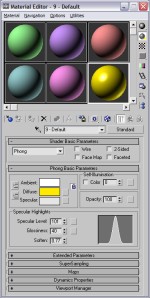
click to enlarge
Above
is a standard view of max 5's material browser -
it hasn't changed greatly in the last 3 versions
of the software (it hasn't needed to). Each
version has added different shader parameters and
functions, but the general layout is the same.
You're allowed 24 material slots, which can then
be applied to various components in the image.
Obviously, it gets rather tricky should you want
to use more than 24 different textures/materials
on a model/scene, but this is unlikely to happen
most of the time.
Textures
are stored as part of a material, so essentially
they are one-and-the-same. All materials are built
up as a series of layers - you select the basic
type, and then add diffuse, bump, specular,
opacity and gloss options (to name only a
few). Each of these sub-types has it's own
roll-out of options to give very fine and precise
control over the system.
Unfortunately
it's not directly possible to export these
material settings to your own models (and hence
your real-time application). It is possible to
plug in your own shader-scripts (for D3D
pixel/vertex shaders) and let an artist customize
the various parameters, you can then export these
parameters and everything should work fine. In the
long term however, max 5 is intending to use
"effect files" - these are a more
generalized (and far more powerful)
graphics-effects language. They are present in
D3D8 (should you know of them, or want to look at
them), but they'll make a bit more of an impact
when D3D9 is released.
Texture mapping is where Max 5
shines, and it shines very brightly indeed. In
many other programs (including previous versions
of 'Max) it was often a rather tedious chore to
texture map objects; this is still the case
occasionally - but much of the irritation has been
removed by the new tools.
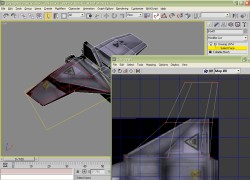
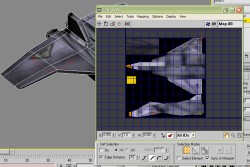
click to enlarge
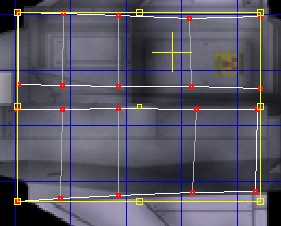
The texturing tools presented in
this software are by far the most intuitive tools
that I've used so far - and I've seen quite a few
now (including making my own). Once you've done
the initial setup you can select the faces from
your model in the main viewport, and they become
active in the "unwrap uvw" modifier
window. You can then manipulate them to display
the correct part of the texture - whilst seeing
the final result re-appear as you make the
changes. Any faces that you select in the uvw
editor will become selected in the main viewport
and vice-versa. When you're actually editing the
UV projection it makes sense to use the new
all-in-one manipulation box (shown in yellow in
the previous screenshot). This gadget has controls
build in for translation, rotation and scaling -
even allowing you to reconfigure the center of
rotation (the yellow cross).
Texture mapping has always been
fairly powerful in 3ds max, version 5 has left the
core tools pretty much the same (no need to fix
something that isn't broken), but it's added a few
useful extra's to smooth over some rough edges in
previous versions. Of most use is probably the new
mapping tools - it's one thing to manually select
all the faces and group them accordingly, but it's
definitely better when you can get 3ds max do it
for you...
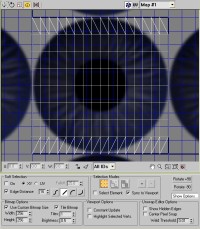
click to enlarge
In the above two images we can see
(on the left) the default mapping for a sphere,
and (on the right) the same sphere mapped using
the "normal mapping" tools. You can also
employ several other new tools to make texture
mapping far easier. For example, when Max 5
unwrapped the sphere above certain edges must be
next to each other (in geometry terms), when you
select the edge of a group, it's corresponding
edge is highlighted - very useful, and if you
want/need them joined up you can select
"stitch" from the menu and Max 5 will
re-join them together for you (see next
screenshot). For more complicated meshes where
there may be "holes" in the UV
projection you can ask max to fill these up with
smaller segments - making optimal use of the
available texture space.
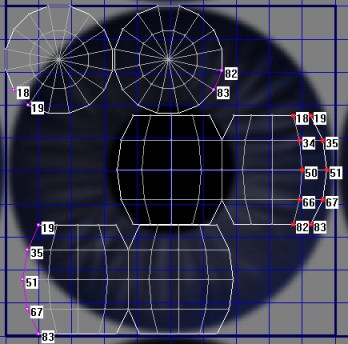
Matching
edges and vertices are shown for easier
projection manipulation.
Rendering
3ds
max has long been used for computer-generated film
rendering (Toy Story and Shrek like films), such
that the final rendered movie(s) and image(s) are
of a high quality. However, this has much less use
for a real-time artist - except for previewing
animations and models.
There
are several occasions however when you won't be
modeling for a real-time scenario - instead you
could be making intro-movies (for games) or a
simple spinning-logo/title screen for a CAD
program, or you could just be making a movie for
personal enjoyment. In my tests, 3ds max 5 is a
bit faster than previous versions, but unless
you're doing work that would normally take several
hours to complete you won't notice the differences
hugely. For those with professional budgets (and
the hardware to match!) multi-processor systems
and network rendering are all supported
out-of-the-box, as well as the simpler 3D
Now!/MMX/SSE instruction extensions.
One
of the big changes for 3ds max 5 in this area is
it's inclusion of a more comprehensive lighting
solution. In previous versions it was necessary to
use other tools and plugins to get a complete
lighting solution for a scene, whereas in Max 5
radiosity and complex ray-tracing is supported by
default.
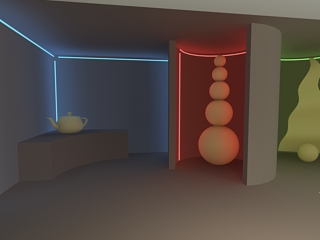
the radiosity test scene. blue is
under-exposed,
red is over-exposed and green is correct.
These lighting solutions will be
of huge benefit if you're rendering static images
and/or movies, but there is little way to make
them useful for real-time art creation. Clever use
of MaxScript may well yield some results, but
out-of-the-box it won't do anything. trueSpace 6's
texture baking, whilst it has many flaws, is a
more useful step for real-time media creation and
advanced lighting.

an example of the images possible with 3ds max 5.
image by Marcelo Souza
Supporting
tools
Out
of the box 3ds max 5 is an extremely powerful
piece of software with more features than most
sane-persons can probably handle. However, it
doesn't stop there - 3ds max packs two more very
powerful punches.
Firstly
we have plugins - a staple product of most 3d
modelers these days. These can be reasonably
easily created using Visual C++ if you have the
MaxSDK (this comes with 3ds max 5). There are
quite a few plugins available from Discreet, but
the majority are going to be from 3rd party
efforts - there are more than enough available for
3ds max 4 that will work fine with max 5. Bare in
mind that some people will charge a small fortune
for their plugins.
Secondly,
if you're not satisfied with making/using plugins,
you can write your own scripts using the built in
MaxScript. Over the last few versions its
progressively evolved from a simple scripting
language to a complete object-oriented programming
language with a very comprehensive API. MaxScript
is definitely something to learn - the power to
customize Max's features to your own liking is a
very useful one. 3ds max 5 comes with all the
tools necessary to use MaxScript built in - all
accessible from a menu in the main UI. You can
even use a "Visual MAX script editor" -
a visual-studio like IDE/dialog editor.


click to enlarge
Working
with games / real-time multimedia
3ds
max 5, as shown over the last few pages has more
than enough powerful features to attract any
real-time artists who aren't already using the
software. It is extremely common to find many
professional studios that use this software - if
you read through any online accounts from
developers/artists, it's so common that they often
refer to it only as "max" - and people
know what they mean.
One of the most
powerful features of MaxScript is that you can
export geometry as you see fit - there are several
common file formats built in, and many more
accessible by downloading plugins, but when it
comes to games (in particular) it is very useful
to export only the information you need, and to
export it in a way that is optimal for reading
quickly or easily streamed. It does mean you need
to learn MaxScript before you can get the most out
of it - there are books thicker than my two books
on C and C++ on this subject alone.
The other aspect
that will interest real-time artists and
development teams is Max's strong use of the
Direct3D API. Combine this with various plugins
and the texture-plugins (shaders) you can allow
artists un-paralleled control over how their art
looks on screen - without spending too much time
writing custom tools.
Max 5 ships with
support for Direct3D8.1 and Direct3D9, although at
time of writing, the D3D9 interfaces won't be
hugely useful for most people - the final release
isn't available yet, there's little hardware with
few drivers available. Also, it was built around
early-releases of the DirectX9 API - something
that is still changing constantly (I'm on the beta
testing program) - the developers are hoping to
avoid a patch to upgrade this part of the program,
but I'd reckon it is quite likely.
Conclusion
Well,
that finishes the 3 page round up of the latest
version of Discreets premier 3D modeling package:
3ds max 5.
It
would be easy to say now that max 5 has improved
on previous versions, rather than make huge
changes they have chosen to revise, smooth and
enhance the software over previous versions. 3ds
max 4 was a powerful piece of software with very
few dissenting voices, so it was necessary for
Discreet to retain a similar overall appearance
for fear of alienating it's existing (huge) user
base. In my opinion, they've done a good
job.
Many
people will be happy with 3ds max 4, but those who
do upgrade will find the many 100's of small
additions, revisions and changes make it well
worth a new release.
The
only problem for many will be the price-tag, at
$3945 as a full package it's not an investment to
take lightly. The chances are that only
professional/semi-professional teams will be able
to justify this price tag - smaller developers
will have to rely on the lower-end solutions.
There is an online form for a demo-CD should you
wish to take a closer look at the software, and
can be found here.
Another
useful thing to bare in mind - you can buy the
software, but it doesn't finish there. 3ds max
has, as I've said several times, a huge user base
- there are literally hundreds of websites,
newsgroups, forums and tutorials available on the
internet. It may take a bit of time before they
take this new version into account, but it'll
definitely happen sooner or later. Discreet also
offers the 'Sparks' program/database for artists -
very similar to the MSDN programming archives (for
those of you who are programmers), if you want to
make full use of this system you do have to pay
for it, but there's a reasonable amount of content
available before you have to pay up.
Previous
Page <<
| Good
Points |
Bad
Points |
| •
Has stuck to the well established
interface of previous versions. |
•
Expensive |
| •
Has changed enough things to warrant a new
release |
•
For all the great revisions, additions and
changes there are few new truly
ground-breaking/revolutionary tools. |
| •
A very good feature-set for real-time
artists / low-polygon modelers. |
•
Requires a high-specification computer. |
| •
A very intuitive interface for
manipulating all features, and is easy to
pick up and get used to. |
•
You need to be a 1/2 decent artist to make
good use of many of the tools provided |
| •
Very strong animation system for
bones/skeletal animation techniques |
•
As intuitive and obvious as the software
gets, it's still not a beginners learning
tool. |
| •
Powerful texture manipulation tools. |
|
| •
Room for expansion - both built in (shader-based
materials) and using MaxScript/plugins. |
|
| •
Many new tools vastly ease/improve
workflow and speed. |
|
| •
Good community/3rd party support |
|
| •
Overall, a very solid product. |
|
Review
Contents:
• Page 1:
Introduction, The Full Package, The User Interface
• Page 2:
Geometry Manipulation, Animation
• Page 3: Textures/Materials, Rendering,
Supporting Tools, real-time multimedia, Conclusion
|

